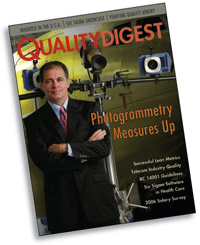|  Editor's note: Sometimes we run articles that just punch the right buttons with our readers. Last month, online articles by Anthony Burns ("Sick Sigma") and David Crosby, brother of the late Phil Crosby ("Zero Defects vs. Six Sigma"), generated a flood of reader response, mostly in support of the authors' positions. The largely negative thrust of opinion regarding Six Sigma begs the question: Is Six Sigma misunderstood, misguided or simply past its prime? Both articles can be found at www.qualitydigest.com/sixsigma. Editor's note: Sometimes we run articles that just punch the right buttons with our readers. Last month, online articles by Anthony Burns ("Sick Sigma") and David Crosby, brother of the late Phil Crosby ("Zero Defects vs. Six Sigma"), generated a flood of reader response, mostly in support of the authors' positions. The largely negative thrust of opinion regarding Six Sigma begs the question: Is Six Sigma misunderstood, misguided or simply past its prime? Both articles can be found at www.qualitydigest.com/sixsigma.
It's nice to see opposing opinion being accepted and reviewed. It takes checks and balances on all macro-level issues to prevent the herd mentality that occurs often in our profession. Maybe with enough of these types of articles, we may lose our reputations for introducing flavors of month.
--Timothy A. Schroeder
Brilliant piece--I love the courage and clarity of thought it demonstrates. Articles like this are what keep me reading Quality Digest. Give that man a medal.
--Peter Schibli
David Crosby's article on Zero Defects vs. Six Sigma is right on target. The Six Sigma approach was fashioned as an alternative to Zero Defects out of the misunderstood notion that zero is an impractical goal for every process. As a concept, allowing a few defects per million is more practical and seems scientifically valid. In addition, Six Sigma requires training a defined number of people in various levels of problem analysis/solving as opposed to Phil Crosby's view that every individual within an organization has a role in improving quality, especially the leadership. An organization that is truly proficient with quality has an embedded culture of doing the right things right while preventing wrong things from occurring, not a series of ongoing projects to fix faulty processes.
--Jim Joyner
I preach Zero Defects. Don't justify rejects; don't make rejects.
--Christopher Clegg
As a degreed and fully experienced quality engineer, I agree with Mr. Paton's comments in "Quality Apathy" ("Quality Curmudgeon," May 2006). Apathy is rampant in U.S. industry. It's not uncommon for people to refer to the quality department with a smile. It's not a smile of pride! It's a smile that seems to say, "As silly as it is."
Yes, there is horrendous apathy in U.S. manufacturing from top to bottom. I am most sorry to say I do not see any change on the horizon. We will leave the next generation a terrible legacy.
--P.D. Corcoran
I think you missed the main part of the problem in "Invented in the U.S.A." ("First Word," Dirk Dusharme, May 2006). The inventors and their support structure--engineers, lawyers, patent clerks, etc.--are mostly white collar people, relatively few in number. The inventions will be produced in China, not the United States. The blue collar workers outnumber the white collars probably 15 or 20 to 1. These are the people whose plants are being shut down and whose jobs, both blue and white collar, are going to China and India.
I facilitate a job club that supports out-of-work manufacturing people--everyone from engineers to vice presidents. Many of these people were downsized because of product being outsourced or killed by imported competition; the rest are looking for work because their many years of experience gave them high salaries and increasing health care costs. The jobs won't come back until the overseas salaries and those in the United States meet somewhere in the gulf that currently exists between them, as well as in the total cost of production, pollution control, transportation, etc.
I worry about the next 20 years and what opportunities my sons will have.
--Juan Chapa
What a great article by Davis Balestracci ("I Hate Bar Graphs--Part 2," "Real World SPC," April 2006)! I immediately recognized that bar graph as something I see on a regular basis. Now we can use an alternate analysis to determine if significant differences exist and where.
After observing the apparent downward trend in the ANOM chart of monthly data, I wondered if a special cause was in play: How many patients put off major health care decisions in the fourth quarter so that they won't get caught paying the "double deductible" for follow-up treatment during the upcoming year?
--Chris Hastings
Once again a great article by Craig Cochran ("Quality Lessons from Hopeulikit," www.qualitydigest.com/qualityinsider). This is a great example of why everyone who is interviewed should be screened and everyone who interviewed the candidate should sit down together and discuss what they thought about the candidate.
--Jody Hemphill
[I think Cochran] missed one of the biggest problems in the manufacturing world. If I, as the past employer, say anything that would be negative about a past employee to a potential employer and the individual finds out, I have just opened myself up to a major lawsuit. So, most employers would rather that the management not say anything than to risk legal action.
--Bruce Eaton
|